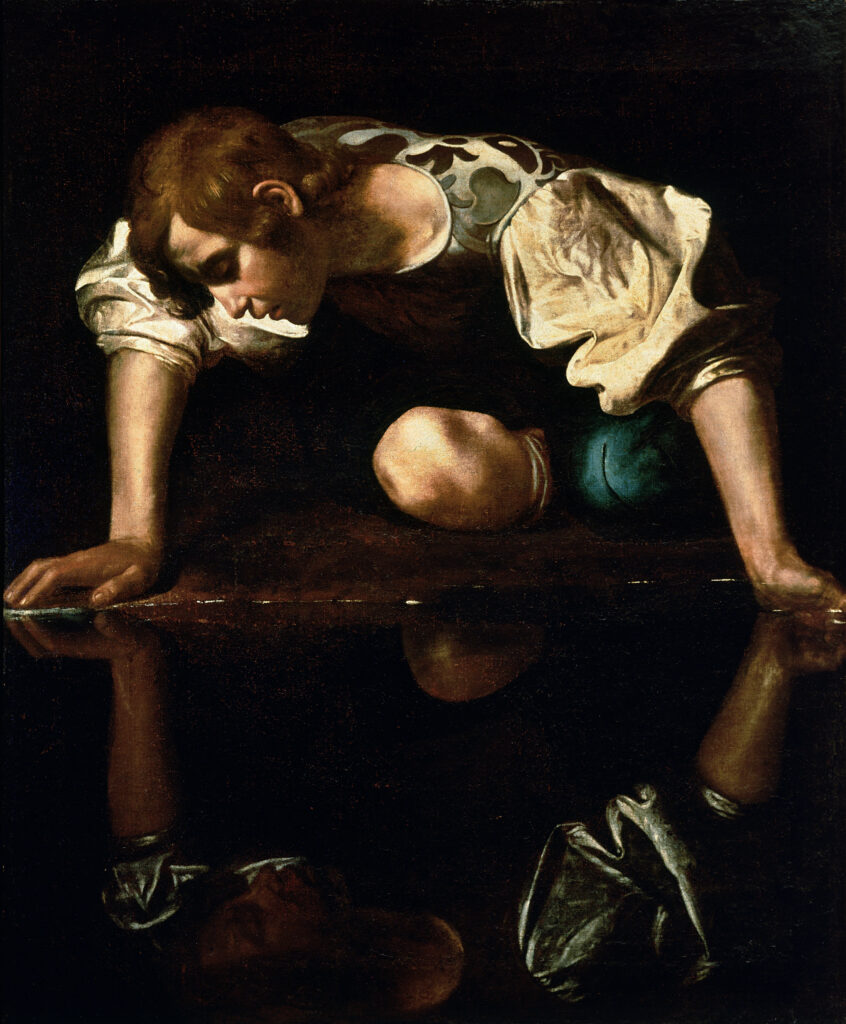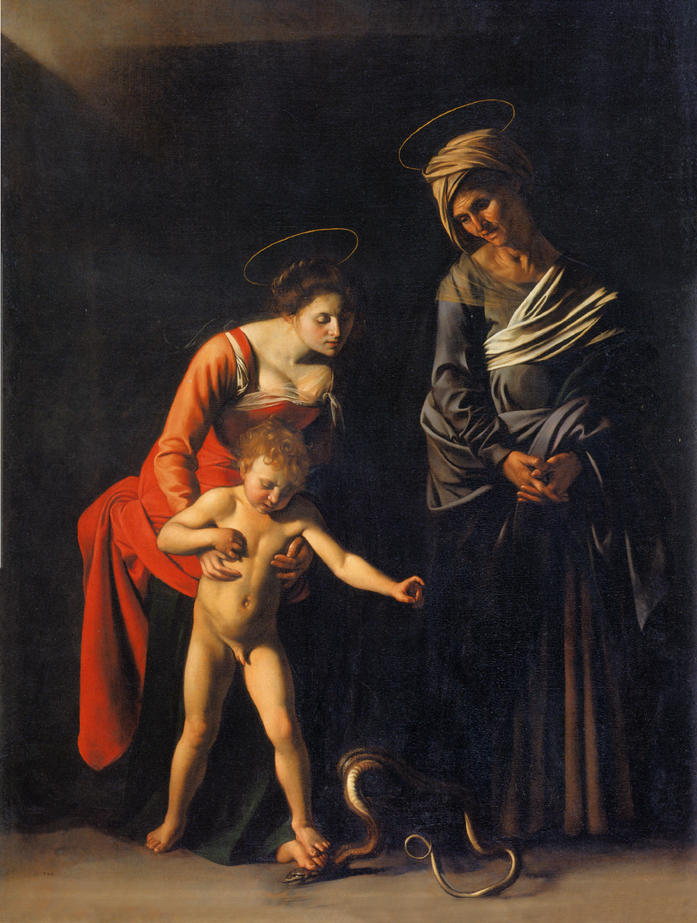Hey there, art buddies! Get ready to strap on your visual seatbelts because we’re diving headfirst into the wild, dramatic, and seriously cool paintings of Caravaggio. This dude was basically the rockstar of the Baroque era, and his paintings? Oh boy, they’re like a fireworks display of light, shadow, and mind-blowing artistic wizardry. So, buckle up for a rollercoaster ride through 10 Caravaggio masterpieces that are so awesome, they might just steal the show at the Louvre’s next blockbuster exhibition!
1. The Calling of Saint Matthew

| Date Completed | 1599-1600 |
| Dimension | 3.3 m × 2.7 m |
| Location | Contarelli Chapel, San Luigi dei Francesi, Rome, Italy |
Let’s kick off this art party with “The Calling of Saint Matthew.” Picture this: divine disco lights shining down on Matthew like he’s about to drop the holiest dance move ever. Caravaggio’s light game is on point, turning a biblical scene into a full-blown spectacle. It’s like Matthew just got invited to the ultimate celestial rager, and we’re here for it!
Now, hold on to your art hats because artist doesn’t just paint; he throws a visual fiesta. The dark, moody vibes set the way for a biblical blockbuster, and that divine light show is the cherry on top. It’s a religious experience with a side of cosmic coolness.
2. Judith Beheading Holofernes

| Date Completed | 1598-1599 |
| Dimension | 1.59 m × 1.32 m |
| Location | Galleria Nazionale d’Arte Antica, Rome, Italy |
Next up, we’ve got “Judith Beheading Holofernes,” and warning: this one’s not your grandma’s Sunday afternoon painting. Caravaggio goes all Quentin Tarantino on us, giving us front-row seats to Judith’s ninja moves. It’s like a Renaissance horror flick, and you might need a bravery biscuit because things are about to get intense.
But hey, we can’t deny the genius in Caravaggio’s paintings. The contrast between light and dark is like watching a horror movie, only in 17th-century technicolor. It’s a gore-fest with an artistic twist, and Caravaggio is the director of our wildest art nightmares.
3. The Supper at Emmaus

| Date Completed | 1601 |
| Dimension | 1.41 m × 1.95 m |
| Location | National Gallery, London, United Kingdom |
Now, let’s cool down with “The Supper at Emmaus.” Imagine a chill dinner party, good vibes all around, and suddenly—boom! Jesus shows up uninvited. Caravaggio captures that “Wait, is this for real?” moment with his epic light skills. You can practically feel the warmth of the bread and the cool vibe of Jesus crashing the dinner scene. It’s the ultimate divine surprise party!
As we stroll through this masterpiece, we can’t help but smile. The warmth of the light, the shock on the disciples’ faces—it’s like a sitcom moment from the Bible. Caravaggio turns a simple supper into a cosmic event, and we’re the enthusiastic hosts of this heavenly shindig.
4. David with the Head of Goliath

| Date Completed | 1610 |
| Dimension | 1.25 m × 1.0 m |
| Location | Galleria Borghese, Rome, Italy |
Now, buckle up for the darker side of Caravaggio with “David with the Head of Goliath.” This one’s like a heavy metal album cover, but instead of guitars, we’ve got a severed head. Caravaggio, the bad boy of art, channels his inner darkness, giving us David with this “I just conquered the unconquerable” look. It’s like the Renaissance version of a horror movie poster, and Caravaggio is the master of artistic nightmares. This masterpiece completed in the year 1610 and can be found at Borghese Gallery and Museum.
But seriously, let’s give props to Caravaggio’s painting skills. The intensity of David’s victory mixed with the brutality of Goliath’s head—it’s like a heavy metal ballad in painting form. Get ready for some serious headbanging art appreciation!
5. The Conversion of Saint Paul

| Date Completed | 1601 |
| Dimension | 2.35 m × 1.75 m |
| Location | Odescalchi Balbi Collection, Rome, Italy |
Time to get spiritual with “The Conversion of Saint Paul.” Imagine Caravaggio as a cosmic cinematographer, capturing the moment when Saul becomes Paul in a divine light show. The blinding light is like a special effect straight out of a Marvel movie, and you can almost feel the spiritual vibes. It’s like a cosmic lightshow, and we’re the front-row VIPs of this heavenly revelation.
As we soak in the glory of this masterpiece, let’s appreciate Caravaggio’s knack for turning a religious event into a blockbuster spectacle. The blinding light, the theatrical composition—it’s like watching the grand finale of a superhero origin story. Caravaggio doesn’t just paint; he directs a cosmic drama, and we’re all part of the audience.
6. Saint John the Baptist

| Date Completed | 1602 |
| Dimension | 1.7 m × 1.05 m |
| Location | Galleria Borghese, Rome, Italy |
Say hi to “Saint John the Baptist,” the rockstar of saints. Caravaggio’s like, “Why be bland when you can be bold?” John’s got this mysterious and androgynous vibe, and the soft light is like Instagram filters before Instagram existed. We’re your animated tour guides, and this ain’t your grandma’s saintly portrait. It’s religious, but it’s fashionable.
We can’t help but be fascinated by how Caravaggio challenges the traditional representations of saints. John’s not your average halo-wearing holy dude; he’s got a vibe, a style, and a soft glow that’s downright ethereal. Caravaggio turns saints into fashion icons, and “Saint John the Baptist” is a testament to his rebellious artistic spirit.
7. Narcissus

| Date Completed | 1597-1599 |
| Dimension | 1.0 m × 1.0 m |
| Location | Galleria Nazionale d’Arte Antica, Rome, Italy |
Time for a mythological pitstop with “Narcissus.” Caravaggio’s like, “Let’s talk about self-love, but make it art.” Narcissus is all about that reflection of life, and Caravaggio uses light to turn it into a deep dive into the psyche. It’s like a psychological thriller, but in painting form.
As we stare at Narcissus, we can’t help but appreciate the subtlety in Caravaggio’s approach. The dude knew how to capture the essence of self-love without making it feel like a cheesy self-help poster. It’s a masterpiece in introspection, and we’re your psychedelic guides on this journey into the mind.
Now, for the grand finale, drumroll, please!
8. Madonna and Child with St. Anne

| Date Completed | 1605-1606 |
| Dimension | 1.18 m × 1.68 m |
| Location | Galleria Borghese, Rome, Italy |
Switching gears to “Madonna and Child with St. Anne.” This one’s like a warm hug from the Virgin Mary. Caravaggio’s mastery isn’t just illuminating; it’s downright cozy. Madonna’s got that proud mom glow, and it’s like a Renaissance family portrait, but with extra love.
As we, your lively tour guides, explore this tender portrayal of maternal love, we can’t help but feel the softness of the light and the warmth of familial bonds. Caravaggio’s treatment of light here goes beyond the physical realm. It’s not just about illuminating the figures; it’s about casting an emotional glow. The soft light that falls on Madonna’s face creates an atmosphere of tenderness and warmth. It’s a celebration of the divine and the human, beautifully intertwined.
9. The Entombment of Christ

| Date Completed | 1602-1603 |
| Dimension | 3.69 m × 2.54 m |
| Location | Vatican Museums, Vatican City |
Now, let’s explore “The Entombment of Christ,” a poignant meditation on grief and loss. Caravaggio’s composition draws us into the heart of the sorrowful moment as Christ’s lifeless body is tenderly placed in the tomb. The use of light here is subdued, yet it conveys the weight of the somber narrative.
In this painting, Caravaggio’s manipulation of light serves a different purpose. It’s not about creating drama or intensity but about evoking a deep emotional response. The subdued light adds a sense of solemnity, inviting contemplation and reflection on the profound sorrow depicted in the scene. As we, your virtual tour guides, navigate through this emotional masterpiece, we encourage you to take a moment and absorb the depth of Caravaggio’s artistic expression.
10. Saint Jerome Writing

| Date Completed | 1605-1606 |
| Dimension | 1.58 m × 1.28 m |
| Location | Oratory of Saint John’s Co-Cathedral, Valletta, Malta |
Our grand finale: “Saint Jerome Writing.” Caravaggio’s like, “Let’s end this with introspection.” The light streaming through the window is like a spotlight on Jerome’s scholarly vibes. It’s like a peaceful retreat into the world of knowledge, and you, dear art explorer, are invited to the ultimate brainy party.
In this final masterpiece, Caravaggio uses light to emphasize the introspective nature of Saint Jerome’s scholarly pursuits. The warm, golden glow of the sunlight creates a serene atmosphere, inviting the viewer into the quiet world of contemplation. It’s a fitting end to our journey through Caravaggio’s masterpieces, leaving us with a sense of awe and appreciation for the interplay of light and artistry.
Frequently Asked Questions
Why was Caravaggio so famous?
Caravaggio’s brief and turbulent life, which was characterized by arrogance, rebellion, and murder, matched the drama of his art. Caravaggio’s paintings were controversial, well-liked, and had a significant influence on future generations of painters throughout Europe. They are distinguished by their dramatic, even theatrical lighting.
Where are Caravaggio’s most famous paintings?
The majority of Caravaggio’s artwork is located in Rome. The famous Young Sick Bacchus (1593–1494), the Boy with a Basket of Fruit (1593–1494), St. Jerome Writing (1605), David with the head of Goliath (1609–1610), and Madonna and Child with St. Anne (1605) can all be found at the Borghese Gallery.
What kind of painting is Caravaggio?
His works had a significant influence on Baroque painting because they mix a realistic study of the physical and emotional states of people with dramatic lighting. Close physical observation and dramatic chiaroscuro, or “tenebrism,” were techniques used by Caravaggio.
What is Caravaggio painting technique?
Caravaggio defined the composition in every last detail with his rapid and loose oil color brushstrokes. Instead of using layers, color paste is used to create the painting.
Conclusion
As we, your enthusiastic tour guides, wrap up this artistic adventure, we hope you’ve enjoyed the whirlwind tour through Caravaggio’s extraordinary paintings. Each painting is like a chapter in the epic tale of Baroque brilliance, and we’re thrilled to have shared this visual journey with you. Until our next artistic escapade, keep the spirit of Caravaggio alive and let the interplay of light guide you through the rich tapestry of art’s extraordinary wonders!













